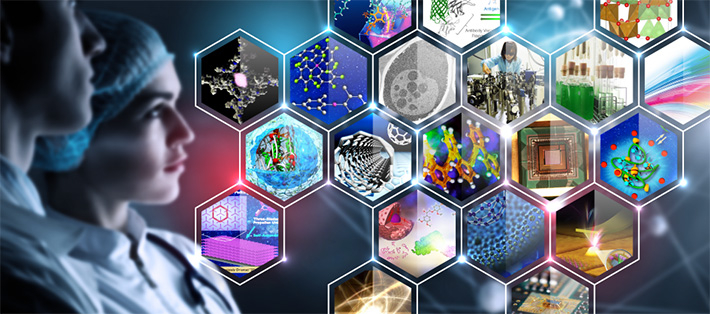
Yasuharu Suematsu, former Tokyo Tech President and current Honorary Professor emphasized to Fumio Koyama, Director General of the Tokyo Tech Institute of Innovative Research (IIR), the importance of conducting full-scale research with the goal of producing innovative and meaningful results for the world. Tokyo Tech began reorganizing its research structure in April 2016 and founded the IIR, which employs approximately 180 faculty members. Fumio Koyama was appointed as the 2nd Director General in April 2018 to accelerate the process. In this feature, we share a discussion between Honorary Professor Yasuharu Suematsu and Fumio Koyama about the direction and importance of IIR research.
Innovative interdisciplinary research
Former Tokyo Tech President, Yasuharu Suematsu, and current IIR Director General, Fumio Koyama, talked about the Institute's progress and future vision, priority research and what the IIR is expected to return to society.
(On August 30, 2018)
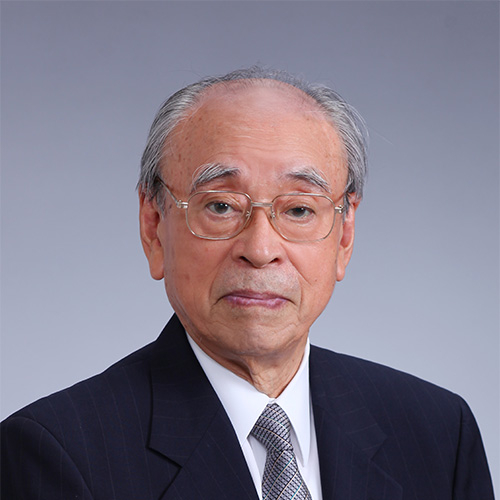
Yasuharu Suematsu
Honorary Professor, Tokyo Institute of Technology/ Chairperson of the Kenjiro Takayanagi Foundation
Born in Gifu Prefecture in 1932. Graduated from Tokyo Tech Department of Science and Engineering in 1955. Earned his Doctorate in Engineering from the Tokyo Tech Graduate School of Science and Engineering in 1960. Joined the Tokyo Tech Precision and Intelligence Laboratory in 1960 as an assistant. Promoted to Assistant Professor at the laboratory in 1961, and Professor in 1973. Became Dean of Tokyo Tech's Department of Engineering in 1986. Elected President of Tokyo Tech for four years from 1989. He has been engaged in research on optical communication, including single-mode semiconductor lasers. Recognition of his achievements include the IEEE James H. Mulligan, Jr. Education Medal in 2003, Japan Prize in 2014 and the Order of Culture in 2015.
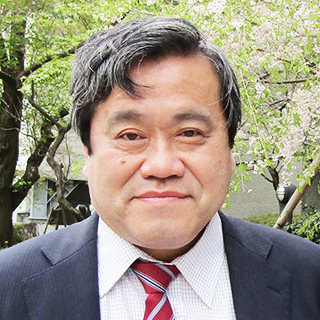
Fumio Koyama
Director General of the Institute of Innovative Research (IIR)/ Professor of Laboratory for Future Interdisciplinary Research of Science and Technology (FIRST)
Born in Tokyo in 1957. Graduated from the Tokyo Tech Department of Science and Engineering in 1980. Earned his Doctorate in Engineering from the Tokyo Tech Graduate School of Science and Engineering in 1985. Became an assistant at the Tokyo Tech Precision and Intelligence Laboratory in 1985. Promoted to Assistant Professor in 1988, and Professor in 2000. Became President of the Laboratory for Future Interdisciplinary Research of Science and Technology (FIRST) in 2016, and Director General of the Institute of Innovative Research (IIR) in 2018. His major area of interest is single-mode semiconductor lasers, surface emitting lasers, and semiconductor optical integrated circuits. His achievements have been recognized with the Prize for Science and Technology by MEXT in 2007, IEEE/LEOS William Streifer Award in 2008 and the Okawa Prize in 2018.
Koyama:Two and a half years ago, Tokyo Tech reorganized its research structure by integrating laboratories and research centers into the newly formed Institute of Innovative Research (IIR). The IIR employs approximately 180 full-time faculty in a wide range of research that includes such diverse areas as biochemistry, materials, nuclear power, energy, electronic information, machine, and disaster control. The total number of researches brings the number of people active at the IIR to approximately 1,000, a number that also includes graduate students. In addition, research units promote and conduct cutting-edge research under outstanding leaders. In July 2018, the Quantum Computing Research Unit was established under the initiative of Professor Hidetoshi Nishimori. This innovative research structure provides a wide range of opportunities for the integration of diverse areas of research.
Suematsu:Establishment of the IIR provides a great opportunity for Tokyo Tech to advance research based on Tokyo Tech's history of outstanding achievements. As we examine what we have accomplished to date, the leading-edge research that has been conducted here and the strong benefits that this research has returned to society, we must consider future global movements to identify future directions of research. Discussions inside the IIR based on predictions about future society will lead to the next step. We then need to move forward with innovative research that has the potential to change existing concepts. It is important for us to create a place for such discussion.
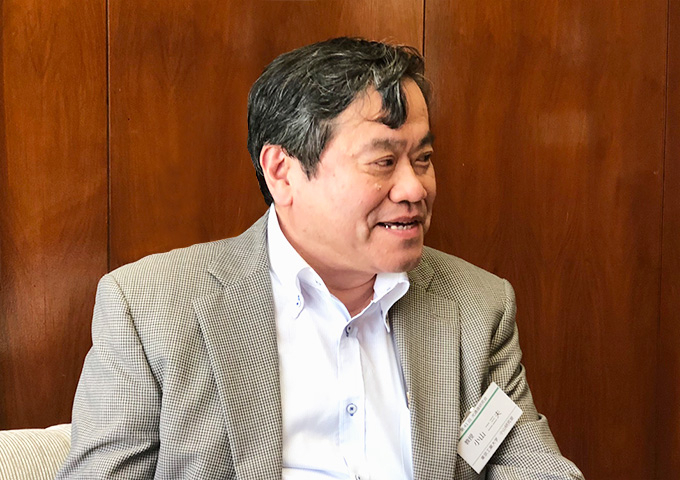
Koyama:We analyze Tokyo Tech's strengths using URA1 at the IIR. With these strengths in mind, we discuss future IIR directions. Universities provide opportunities for research based on individual initiative while new research fields require completely innovative thinking. Collaboration with other research fields promotes such opportunities. With support from industry, we are planning to establish an organization for IoT research. What do you think is the best way to advance interdisciplinary research?
Suematsu:Let's take the example of quantum computing. Full-scale implementation of quantum computing requires both software and hardware as well as applied studies. In the end, it is essential for us to conduct interdisciplinary research.
Research on artificial intelligence (AI) in Japan tends to be more applied while researchers in North America and China focus more on basic aspects of AI such as reasoning and learning, which look, for example, to increase the efficiency of AI functions. I think we should also increase the number of people at Tokyo Tech who are doing applied as well as basic research.
In 2016, Tokyo Tech established a funding platform to support digital system research for social infrastructure in the 21st century. AI, high-performance/high-capacity optical communication and big data are important digital systems; and the earlier we initiate such research, the more significant our achievements will be.
Koyama:Along with the advancement of AI studies, a priority has been placed on hardware, including edge computers2, to accelerate interdisciplinary research.
Suematsu:It is ill-advised, though, to focus exclusively on devices. It is necessary to advance research only after understanding the entire system and its impact on society. The IIR allows researchers from a wide range of research fields to achieve this goal, I expect the IIR to result in great achievements.
Koyama:Industry-university collaboration is now focused on organizational cooperation for broader, more effective joint projects than is possible through the existing system involving tie-ups with individual researchers. This is an essential framework of collaboration between laboratories or IIR research units. We have been advancing such organizational collaboration with companies both at home and abroad, and the results have manifest themselves in Collaborative research chairs3. This open innovation concept allows for significantly greater cooperation with industry, which increases our ability to meet and exceed expectations. I think the long-term research on optical communication you have advanced through industry-university collaboration will provide an excellent model for us.
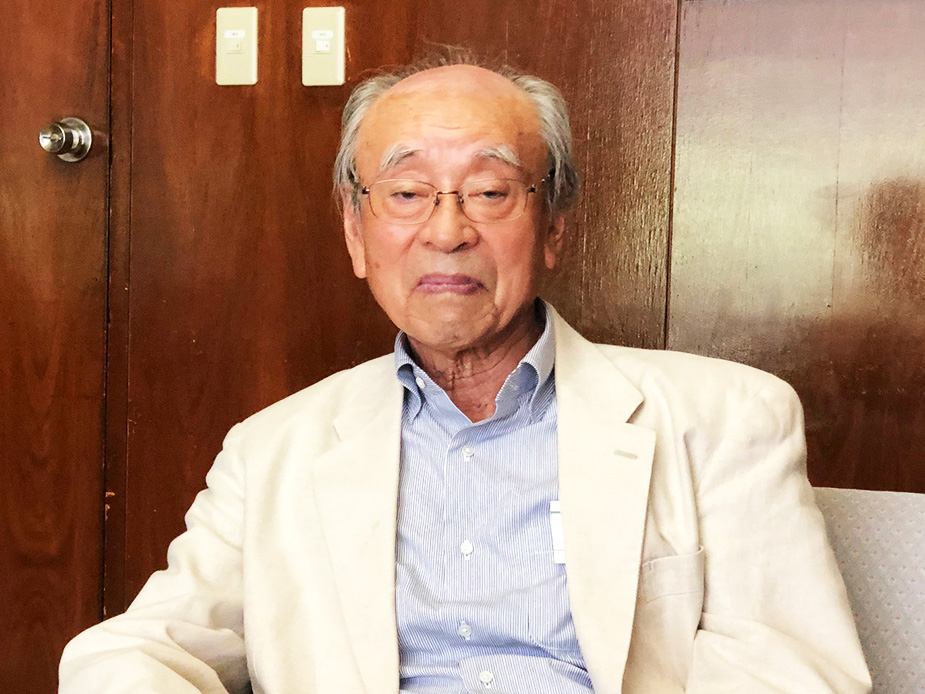
Suematsu:I think it is first essential to clearly identify the roles of industries and universities before embarking on collaboration so that full-scale research can be undertaken with the goal of producing completely novel results that have the potential to drive global trends. Achieving this requires flexible structures established in cooperation with experienced individuals from industry.
Koyama:Do you have any advice for young researchers?
Suematsu:Young researchers should consider ideas that can change the world and pursue innovation rather than simply attempting improvements on existing themes. Ideas will occur during active discussions among you and your colleagues. It is also important to have an environment that brings you into contact with people outside of your organizations to spark new ideas for research.
Koyama:Thank you so much for being here today. Your input will certainly help us to further the goals of the IIR.
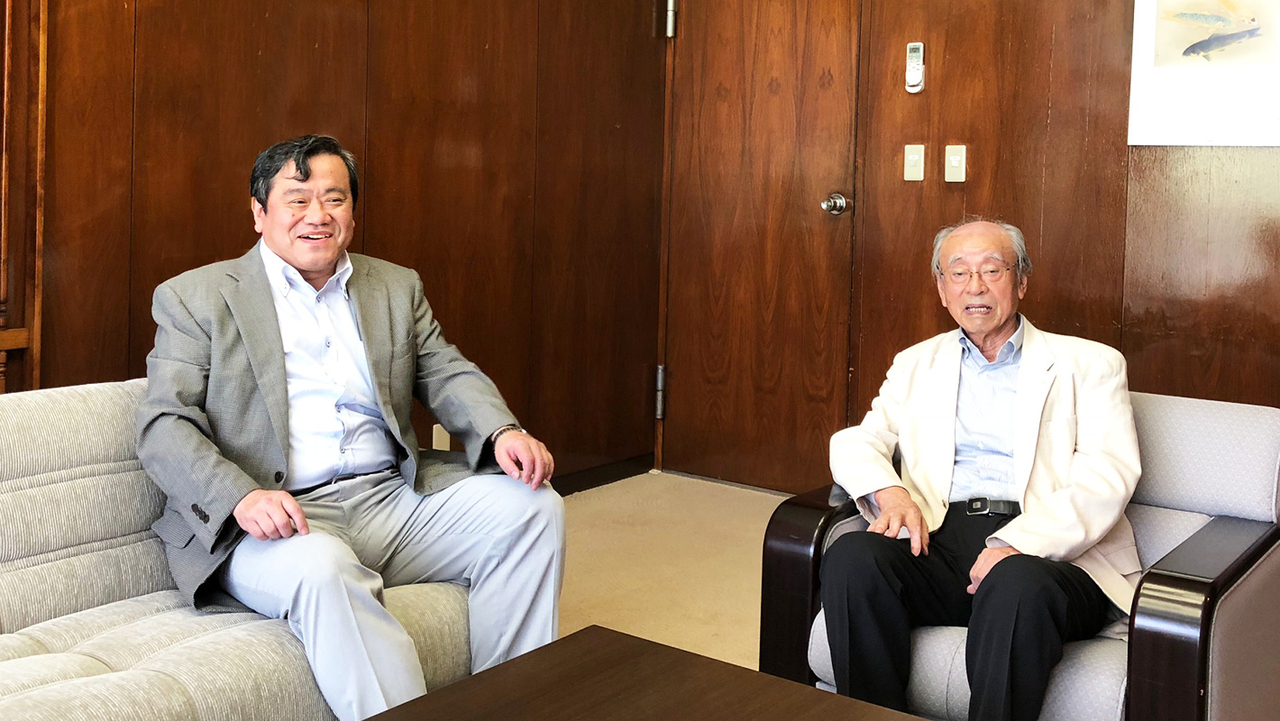
The most advanced research at Tokyo Tech's laboratories
Tokyo Tech has a tradition of respecting independent thought and research in basic applied fields. We would now like to introduce some of the cutting-edge research taking place at Tokyo Tech, research made possible through diversity of thought and sharpness of mind.
Laboratory for Future Interdisciplinary Research of Science and Technology (FIRST) — Surgical robots on the leading edge of future medical care —
The mission of FIRST is to create innovative industrial technologies through interdisciplinary collaboration leading to practical implementation. An example of this is FIRST's work to enhance safety and security in an aging society with fewer children being born through its Research Center for Biomedical Engineering Project4 in cooperation with the Tokyo Medical and Dental University, Hiroshima University, and Shizuoka University. This project promotes interdisciplinary collaboration in the fields of medicine, dentistry, and engineering.
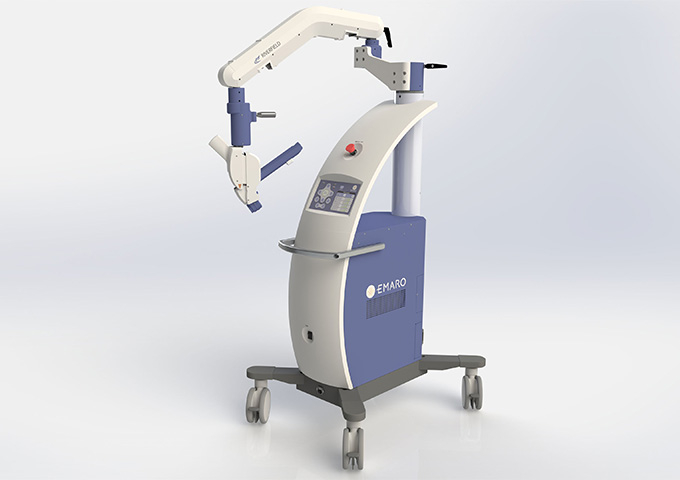
EMARO, an endoscope holder robot
Surgical robots have traditionally been "hard robots" incorporating precision machine elements and servo control technologies that respond to the movements of the surgeon's hands during procedures. The problem, however, was that surgeons operating the robot were unable to feel the movement of the robotic instruments in contact with the body during surgery. "Soft robots" that employ pneumatic actuators changed this by enabling surgeons to make more flexible movements suitable for the procedures being performed. These soft robots have been highly regarded by physicians; and they have been effectively employed through the Tokyo Tech venture project, RIVERFIELD Inc., which introduced EMARO, an endoscope holder robot, to the market in 2015. EMARO has been adopted by university hospitals and many other medical institutions.
FIRST has also begun joint research on robotic hands while preparing for Collaborative research chairs aimed at deepening our studies and further developing high-functional robots.
FIRST employs many researchers in a wide range of fields, including information, electricity and electronics, machine, materials, and urban disaster control to advance interdisciplinary research over a broad spectrum of areas.
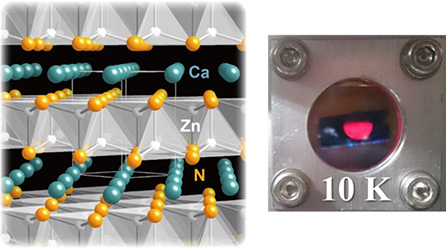
Crystal structure of CaZn2N2 (left) and red luminescence (right)
The Laboratory for Materials and Structures (MSL) develops completely novel functional materials using perspectives and ideas that differ from the existing approaches with a focus on inorganic materials consisting of a wide range of elements. Examples of these are amorphous oxide semiconductors for large-scale organic electroluminescence (EL) displays, iron pnictide superconductors, electride catalysts whose electrons function as negative ions to significantly reduce the temperature and pressure required for ammonia synthesis, topological electronic materials that did not exist in the field of solid physics in the 20th century, negative thermal expansion materials that shrink when heated, and unbreakable ceramics.
In order to identify and design novel materials beyond our existing knowledge, we depend on first-principle quantum calculations6. The MSL reinforces its theoretical calculation group and promotes interdisciplinary research with other groups capable of handling materials that are challenging to synthesize. For example, identifying nitride semiconductors, which have high environmental affinity, high mobility and a direct transition-type band gap, using a comprehensive first-principle quantum calculation allowed us to predict a theoretical new semiconductor material, CaZn2N2 (see the figure). While the synthesis of this material had not been reported, the theoretical calculation of stable conditions allowed us to predict that we could accomplish this at a high nitrogen pressure. We succeeded in synthesizing the material under 5 GPa (an approximate atmospheric pressure of 50,000). The actual band gap was also close to the predicted gap at 1.9 eV, and the red luminescence shown in the figure was observed.
Such cooperation among specialists engaged in establishing a new concept of materials, material designing concept, theoretical calculation, and cutting-edge measurement allows us to develop novel materials.
Laboratory for Chemistry and Life Science — Nano machines that realize diagnoses and therapies as expected —
The Laboratory for Chemistry and Life Science (CLS) has been engaged in broad research in both chemistry and the life sciences. The Nishiyama Study Group conducts research for future medical care merging the fields of chemistry and life science. The group is working on the development of nanomachines for diagnostic and therapy systems that make it possible to deliver the required functions to target sites with minimum invasiveness through the provision of smart functions, such as the ability to respond to microenvironments or connect with targets, to a synthetic polymer7 and aggregates. Such nanomachines are required to function mutually with target cells after reaching lesions while not triggering an immune response in the body. Therefore, we developed a new polymer (betaine polymer) that changes characteristics depending on the hydrogen ion concentration (pH) inside blood and tumors. The betaine polymer has greater than triple the solid carcinoma clustering property as broadly used polyethylene glycol (PEG)8 modified semiconductors do, which allows it to be effectively absorbed by cancer cells. Using this new polymer with its extremely functional properties as the outer layer material for nanomachines, CLS has carried out research on pinpoint therapies for solid carcinoma.
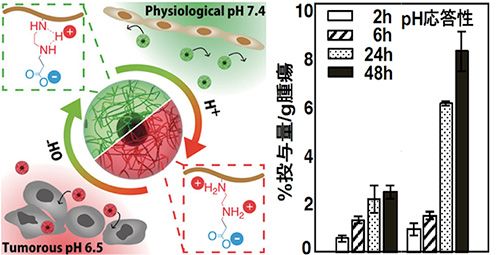
PH-responsive betaine polymer that functions as the shell for nanomachines and the solid carcinoma clustering property of betaine polymer modification quantum dots (QD)
Laboratory for Advanced Nuclear Energy — Passing down "Revitalizics" to posterity —
The Laboratory for Advanced Nuclear Energy (LANE) has been promoting multidisciplinary studies for early realization of Fukushima Innovation Coast Framework (Fukushima International Research Industrial City) focusing on the following three themes with the goal of establishing new industrial infrastructures in the Hamadori (coastal area in Fukushima Prefecture) that suffered damage in the Great East Japan Earthquake and nuclear power plant disaster:
- 1.
-
Approaches to restoration of the environment such as soil contaminated by nuclear material (decontamination sciences)
- 2.
-
Approaches to acceleration of reactor decommissioning using robot measurement (robot measurement engineering)
- 3.
-
Approaches to shared responsibilities for risks and enhancing trust (risk communication engineering)
In regard to the first theme, we succeeded in a significant reduction of spatial radiation dose in the area and high reduction of the volume9 of final waste disposal to more than 1/10,000 through the stable solidification of cesium in glass after complete removal from clay minerals in soil and combustion ash by high-speed ion-exchange method using subcritical water10. In regard to the second theme, we are advancing development of remote measurement and robot technology to reduce risk in fuel debris retrieval from decommissioned nuclear reactors. In regard to the third theme, we have developed effective risk communication engineering methods aiming to establish a reliable means of risk management to ensure a safe and secure environment for the residents.
We will systematize these results to establish a new academic field called "Revitalizics". In addition, we will cultivate human resources through practical training at graduate schools, ICT education support at elementary and junior high schools, and contributions to the industrial development in cooperation with regional companies and local governments not only to realize the Fukushima Innovation Coast Framework as early as possible, but also to pass down the technologies and wisdom, which are required to restore the regions after the unprecedented nuclear disaster, to later generations.

Towards the Realization of Fukushima Innovation Coast Framework
1 URA
URA is an abbreviation of University Research Administrator. The URA is a highly-skilled specialist who supports researchers at universities and other institutions as well as handling aspects of research management. The URA functions as a bridge for the implementation of knowledge gained at universities into society in a wide range of forms.
2 Edge computers
Edge computers process data at the user side, or the edge of networks.
3 Collaborative research chairs
The organization for joint research project is initiated at universities through corporate funding. Different from existing joint research, this project facilitates the establishment of a stable infrastructure for new research expansions.
4 Research Center for Biomedical Engineering Project
This is a network-based joint research center established in 2016 and certified by the Ministry of Education, Culture, Sports, Science and Technology. In involves four research institutions, the Tokyo Medical and Dental University Institute of Biomatetrials and Bioengineering (IBB), the Tokyo Institute of Technology FIRST, the Hiroshima University Research Institute for nanodevice and Bio Systems (RNBS), and the Shizuoka University Research Institute of Electronics. This center promotes cutting-edge joint research in the field of biomedical engineering through the network of these four institutions, and promotes practical applications of biomaterials, medical devices and medical systems in Japan. For example, it has been engaged in the development of surgical robots, breast cancer diagnosis devices, novel dental materials and brain measurement devices using near-infrared light.
5 Materials informatics
This field of study seeks to develop novel materials and functions by evaluating a tremendous amount of materials utilizing and combining computational sciences, data sciences, synthesis and evaluation experiments.
6 First-principle quantum calculation
This method is used to calculate the state of electrons that control the properties of materials and highly-accurate total energy using atomic arrangement based on the basic principle of quantum mechanics. It allows prediction of structures and properties of crystals and molecules.
7 Synthetic polymer
This compound consists of more than 10,000 molecules artificially created through the polymerization of monomers.
8 Polyethylene glycol (PEG)
A water-soluble synthetic polymer consists of a polyethylene glycol repeating unit that does not absorb protein. It is employed in the field of pharmaceuticals.
9 High reduction of the volume
Radioactive substances are reduced to stable solid wastes for disposal. Significantly reducing the volume of the solid wastes compared with the original volume of contaminated soil is called high volume reduction.
10 High-speed ion-exchange method using subcritical water
Subcritical water temperature and pressure are lower than the critical point (374 degrees C, 22.1 MPa). Such subcritical water is capable of exchanging metal ions adsorbed between narrow layers such as those found in clay minerals.
The Special Topics component of the Tokyo Tech Website shines a spotlight on recent developments in research and education, achievements of its community members, and special events and news from the Institute.
Past features can be viewed in the Special Topics Gallery.
. Any information published on this site will be valid in relation to Science Tokyo.













